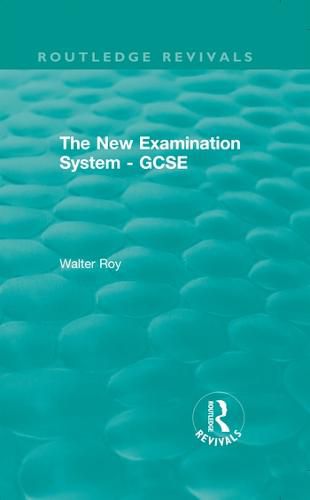Readings Newsletter
Become a Readings Member to make your shopping experience even easier.
Sign in or sign up for free!
You’re not far away from qualifying for FREE standard shipping within Australia
You’ve qualified for FREE standard shipping within Australia
The cart is loading…






Reform of the public examination system for sixteen-year-olds presented a considerable challenge to secondary schools. The new General Certification of Secondary Education, introduced in 1988, was more than a continuation of the G.C.E. ‘O’ level and C.S.E. examinations at the time. The introduction of national criteria by the Department of Education, the part played by the Secondary Schools Examination Council, the emergence of new examining bodies were new dimensions faced by schools accustomed to exercising considerable autonomy in designing a curriculum. How far would the new examination reflect what was actually taught in our classrooms? What were its new features? Which pupils would be entered, and with what prospect of success? Above all, how would schools meet a tight time schedule, which required study of new syllabuses to be ready by 1986 for the first examinations held in 1988? Originally published in 1986 this book was intended to answer some of these questions and provide an up-to-date picture of the present state of the examination world, with indications of future developments in the vital years ahead. It aimed to assist those immediately and urgently concerned with implementing this far-reaching educational reform. Today it can be considered in its historical context.
$9.00 standard shipping within Australia
FREE standard shipping within Australia for orders over $100.00
Express & International shipping calculated at checkout
Reform of the public examination system for sixteen-year-olds presented a considerable challenge to secondary schools. The new General Certification of Secondary Education, introduced in 1988, was more than a continuation of the G.C.E. ‘O’ level and C.S.E. examinations at the time. The introduction of national criteria by the Department of Education, the part played by the Secondary Schools Examination Council, the emergence of new examining bodies were new dimensions faced by schools accustomed to exercising considerable autonomy in designing a curriculum. How far would the new examination reflect what was actually taught in our classrooms? What were its new features? Which pupils would be entered, and with what prospect of success? Above all, how would schools meet a tight time schedule, which required study of new syllabuses to be ready by 1986 for the first examinations held in 1988? Originally published in 1986 this book was intended to answer some of these questions and provide an up-to-date picture of the present state of the examination world, with indications of future developments in the vital years ahead. It aimed to assist those immediately and urgently concerned with implementing this far-reaching educational reform. Today it can be considered in its historical context.